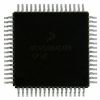Description
Features:
Specifications
Description
This is the Introduction of MC9S12C-Family and MC9S12GC-Family: The MC9S12C-Family / MC9S12GC-Family are 48/52/80 pin Flash-based MCU families, which deliver the power and flexibility of the 16-bit core to a whole new range of cost and space sensitive, general purpose industrial and automotive network applications. All MC9S12C-Family / MC9S12GC-Family members feature standard on-chip peripherals including a 16-bit central processing unit (CPU12), up to 128K bytes of Flash EEPROM, up to 4K bytes of RAM, an asynchronous serial communications interface (SCI), a serial peripheral interface (SPI), an 8-channel 16-bit timer module (TIM), a 6-channel 8-bit pulse width modulator (PWM), an 8-channel, 10-bit analog-to-digital converter (ADC).
The MC9S12C128-Family members also feature a CAN 2.0 A, B software compatible module (MSCAN12). All MC9S12C-Family / MC9S12GC-Family devices feature full 16-bit data paths throughout. The inclusion of a PLL circuit allows power consumption and performance to be adjusted to suit operational requirements. In addition to the I/O ports available in each module, up to 10 dedicated I/O port bits are available with wake-up capability from stop or wait mode. The devices are available in 48-, 52-, and 80- pin QFP packages, with the 80-pin version pin compatible to the HCS12 A, B, and D Family derivatives.
And these are the Features: the first one is 16-bit HCS12 core, which means: HCS12 CPU; Upward compatible with M68HC11 instruction set; Interrupt stacking and programmer's model identical to M68HC11; Instruction queue; Enhanced indexed addressing; MMC (memory map and interface); INT (interrupt control); BDM (background debug mode); DBG12 (enhanced debug12 module, including breakpoints and change-of-flow trace buffer); MEBI (multiplexed expansion bus interface) available only in 80-pin package version. And the second one is Wake-up interrupt inputs, which means: Up to 12 port bits available for wake up interrupt function with digital filtering Memory options. And the third one is Analog-to-digital converters, which means: One 8-channel module with 10-bit resolution; External conversion trigger capability. And the forth one is Available on MC9S12C Family, which include: One 1M bit per second, CAN 2.0 A, B software compatible module; Five receive and three transmit buffers; Flexible identifier filter programmable as 2 x 32 bit, 4 x 16 bit, or 8 x 8 bit; Four separate interrupt channels for Rx, Tx, error, and wake-up; Low-pass filter wake-up function; Loop-back for self test operation.

 MC9S12GC Data Sheet
MC9S12GC Data Sheet






